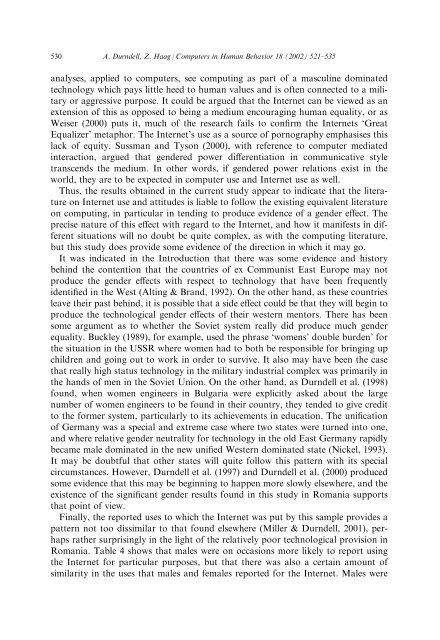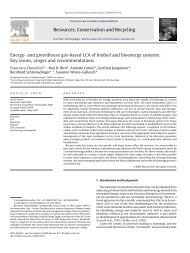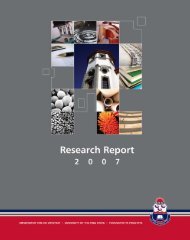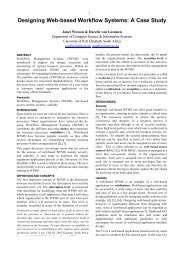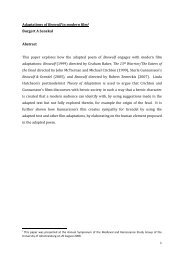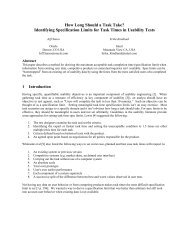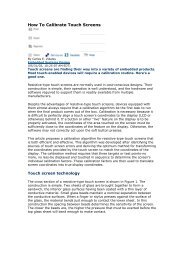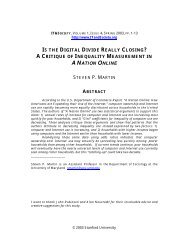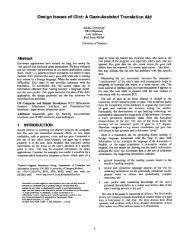Computer self efficacy, computer anxiety, attitudes towards the ...
Computer self efficacy, computer anxiety, attitudes towards the ...
Computer self efficacy, computer anxiety, attitudes towards the ...
You also want an ePaper? Increase the reach of your titles
YUMPU automatically turns print PDFs into web optimized ePapers that Google loves.
530 A. Durndell, Z. Haag / <strong>Computer</strong>s in Human Behavior 18 (2002) 521–535analyses, applied to <strong>computer</strong>s, see computing as part of a masculine dominatedtechnology which pays little heed to human values and is often connected to a militaryor aggressive purpose. It could be argued that <strong>the</strong> Internet can be viewed as anextension of this as opposed to being a medium encouraging human equality, or asWeiser (2000) puts it, much of <strong>the</strong> research fails to confirm <strong>the</strong> Internets ‘GreatEqualizer’ metaphor. The Internet’s use as a source of pornography emphasises thislack of equity. Sussman and Tyson (2000), with reference to <strong>computer</strong> mediatedinteraction, argued that gendered power differentiation in communicative styletranscends <strong>the</strong> medium. In o<strong>the</strong>r words, if gendered power relations exist in <strong>the</strong>world, <strong>the</strong>y are to be expected in <strong>computer</strong> use and Internet use as well.Thus, <strong>the</strong> results obtained in <strong>the</strong> current study appear to indicate that <strong>the</strong> literatureon Internet use and <strong>attitudes</strong> is liable to follow <strong>the</strong> existing equivalent literatureon computing, in particular in tending to produce evidence of a gender effect. Theprecise nature of this effect with regard to <strong>the</strong> Internet, and how it manifests in differentsituations will no doubt be quite complex, as with <strong>the</strong> computing literature,but this study does provide some evidence of <strong>the</strong> direction in which it may go.It was indicated in <strong>the</strong> Introduction that <strong>the</strong>re was some evidence and historybehind <strong>the</strong> contention that <strong>the</strong> countries of ex Communist East Europe may notproduce <strong>the</strong> gender effects with respect to technology that have been frequentlyidentified in <strong>the</strong> West (Alting & Brand, 1992). On <strong>the</strong> o<strong>the</strong>r hand, as <strong>the</strong>se countriesleave <strong>the</strong>ir past behind, it is possible that a side effect could be that <strong>the</strong>y will begin toproduce <strong>the</strong> technological gender effects of <strong>the</strong>ir western mentors. There has beensome argument as to whe<strong>the</strong>r <strong>the</strong> Soviet system really did produce much genderequality. Buckley (1989), for example, used <strong>the</strong> phrase ‘womens’ double burden’ for<strong>the</strong> situation in <strong>the</strong> USSR where women had to both be responsible for bringing upchildren and going out to work in order to survive. It also may have been <strong>the</strong> casethat really high status technology in <strong>the</strong> military industrial complex was primarily in<strong>the</strong> hands of men in <strong>the</strong> Soviet Union. On <strong>the</strong> o<strong>the</strong>r hand, as Durndell et al. (1998)found, when women engineers in Bulgaria were explicitly asked about <strong>the</strong> largenumber of women engineers to be found in <strong>the</strong>ir country, <strong>the</strong>y tended to give creditto <strong>the</strong> former system, particularly to its achievements in education. The unificationof Germany was a special and extreme case where two states were turned into one,and where relative gender neutrality for technology in <strong>the</strong> old East Germany rapidlybecame male dominated in <strong>the</strong> new unified Western dominated state (Nickel, 1993).It may be doubtful that o<strong>the</strong>r states will quite follow this pattern with its specialcircumstances. However, Durndell et al. (1997) and Durndell et al. (2000) producedsome evidence that this may be beginning to happen more slowly elsewhere, and <strong>the</strong>existence of <strong>the</strong> significant gender results found in this study in Romania supportsthat point of view.Finally, <strong>the</strong> reported uses to which <strong>the</strong> Internet was put by this sample provides apattern not too dissimilar to that found elsewhere (Miller & Durndell, 2001), perhapsra<strong>the</strong>r surprisingly in <strong>the</strong> light of <strong>the</strong> relatively poor technological provision inRomania. Table 4 shows that males were on occasions more likely to report using<strong>the</strong> Internet for particular purposes, but that <strong>the</strong>re was also a certain amount ofsimilarity in <strong>the</strong> uses that males and females reported for <strong>the</strong> Internet. Males were


